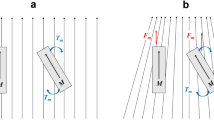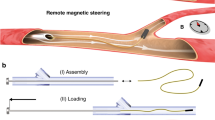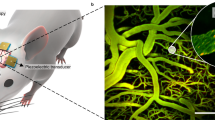Abstract
The field of microrobotics dedicated to medical interventions although relatively new, is progressing at a very fast pace. Among the various accesses inside the body being investigated, the vascular network with close to 100,000 km of potential routes in each human and offering a large range of interventional opportunities has been of special interest in recent years. Although significant progresses and milestones have been achieved in this particular field of research, some important challenges remain to be solved before microrobotics in the human vasculature becomes a reality. Nonetheless, despite these challenges, some applications are already on the horizon. This paper aims at providing a quick overview of the present status of the field of microrobotics for interventions in the vascular network and to describe the main critical challenges that must be met in the short term to enable new or enhanced medical interventional procedures that may bring potential great outcomes for the patients.


Similar content being viewed by others
References
Jain KK (2005) Editorial: targeted drug delivery for cancer. Technology in Cancer Treatment 4(4):311–313
Nguyen KT (2011) Targeted nanoparticles for cancer therapy: promises and challenges. J Nanomedicine and Nanotechnology 2(5)
Pouponneau P, Leroux J-C, Martel S (2009) Magnetic nanoparticles encapsulated into biodegradable microparticles steered with an upgraded magnetic resonance imaging system for tumor chemoembolization. Biomaterials 30(31):6327–6332
Olamaei N, Cheriet F, Martel S (2011) Accurate positioning of magnetic microparticles beyond the spatial resolution of clinical MRI scanners using susceptibility artifacts. In Proc. 33rd Annual Int. Conf. of the IEEE Eng. in Medicine and Biology Society (EMBC), Boston, USA
Olamaei N, Beaudoin G, Cheriet G, Martel S (2010) MRI visualization of a single 15 μm navigable imaging agent and future microrobot. 32nd Annual International Conference of the IEEE Engineering in Medicine and Biology Society (EMBC), Buenos Aires, Argentina
Martel S, Mathieu J-B, Felfoul O, Chanu A, Aboussouan É, Tamaz S, Pouponneau P, Beaudoin G, Soulez G, Yahia L’H, Mankiewicz M (2007) Automatic navigation of an untethered device in the artery of a living animal using a conventional clinical magnetic resonance imaging system. Appl Phys Lett 90:114105
Felfoul O, Mathieu J-B, Beaudoin G, Martel S (2008) MR-tracking based on magnetic signature selective excitation. IEEE Trans on Medical Imaging 27(1):28–35
Pouponneau P, Leroux J-C, Soulez G, Gaboury L, Martel S (2011) Co-encapsulation of magnetic nanoparticles and doxorubicin into biodegradable microcarriers for deep tissue targeting by vascular MRI navigation. Biomaterials 32(13):3481–3486
Mathieu J-B, Martel S (2009) Aggregation of magnetic microparticles in the context of targeted therapies actuated by a magnetic resonance imaging system. J Appl Phys 106: 044904-1 to 7
Mathieu J-B, Martel S (2010) MRI Steering of aggregating magnetic microparticles for enhanced therapeutic efficacy in cancer targeting. Magn Reson Med 63:1336–1345
Beyer T, Towsend DW, Brun T, Kinahan PE, Charron M, Roddy R, Jerin J, Young J, Byars L, Nutt R (2000) A combined PET/CT scanner for clinical oncology. J Nucl Med 41(8):1369–1379
Seemann MD (2005) Whole-body PET/MRI: the future in oncological imaging. Technol Cancer Res Treat 4(5):577–582
Judenhofer MS et al (2008) Simultaneous PET-MRI: a new approach for functional and morphological imaging. Nat Med 14:459–465
Pichler BJ, Kolb A, Nagele T, Schlemmer H-P (2010) PET/MRI: paving the way for the next generation of clinical multimodality imaging applications. J Nucl Med 51(3):333–336
Martin A, Weber O, Saloner D, Higashida R, Wilson M, Saaed M, Higgins C (2002) Application of MR technology to endovascular interventions in an XMR Suite. Medicamundi 46(3):28–34
Belharet K, Folio D, Ferreira A (2010) Endovascular navigation of a ferromagnetic microrobot using MRI-based predictive control. In Proc. IEEE/RSJ Int. Conf. on Intelligent Robots and Systems (IROS), Taipei, Taiwan, pp 2804-2809
Brody WR (1982) Digital subtraction angiography. IEEE Trans Nuclear Science 29(3):1176–1180
Tobis JM, Nalcioglu O, Henry WL (1983) Digital subtraction angiography. Chest 84(1):68–75
Weinstein PR (1983) Digital subtraction angiography. Clin Neurosurg 31:90–106
Olamai N, Cheriet F, Martel S (2012) 3D reconstruction of microvasculature in MRI using magnetic microparticles. In Proc. 11th Int. Conf. on Information Sciences, Signal Processing and their Applications, Montréal
Nelson BJ, Kaliakatsos IK, Abbott JJ (2010) Microrobots for minimally invasive medicine. Annu Rev Biomed Eng. pp 55-85
Jiles DC (2003) Recent advances and future directions in magnetic materials. Acta Mater 51:5907–5939
Carpi F, Pappone C (2009) Stereotaxis Niobe magnetic navigation system for endocardial catheter ablation and gastrointestinal capsule endoscopy. Expert Rev Med Devices 6(5):487–498
Valdalstri P, Sinibaldi E, Caccavaro S, Tortora G, Menciassi A, Dario P (2011) A novel magnetic actuation system for miniature swimming robots. IEEE Trans Robot 27(4):769–779
Kummer MP, Abbott JJ, Kratochvil BE, Borer R, Sengul A, Nelson BJ (2010) OctoMag: an electromagnetic system for 5-DOF wireless micromanipulation. IEEE Trans Robot 26(6):1006–1017
Keller H, Juloski A, Kawano H, Bechtold M, Kimura A, Takizawa H, Kuth R (2012) Method for navigation and control of a magnetically guided capsule endoscope in the human stomach. The 4th IEEE RAS/EMBS Int. Conf. on Biomedical Robotics and Biomechatronics (BioRob), Roma, Italy, pp 859-865
Mathieu J-B, Beaudoin G, Martel S (2006) Method of propulsion of a ferromagnetic core in the cardiovascular system through magnetic gradients generated by an MRI system. IEEE Trans Biomed Eng 53(2):292–299
Schaefer DJ, Bourland JD, Nyenhuis JA (2000) Review of patient safety in time-varying gradient fields. J Magn Reson Imaging 12:20–29
Price RR (1999) The AAPM/RSNA physics tutorial for residents: MR imaging safety considerations. Radiographics 19:1641–1651
Yu C, Kim J, Choi H, Choi J, Jeong S, Cha K, Park J, Park S (2010) Novel electromagnetic actuation system for three-dimensional locomotion and drilling of intravascular microrobot. Sensors and Actuators A: Physical 161(1–2):297–304
Kosa G, Jakab P, Szekely G, Hata N (2012) MRI driven magnetic microswimmers. Biomed Microdevices 14(1):165–178
Watson B, Friend J, Yeo L (2010) Modelling and testing of a piezoelectric ultrasonic micro-motor suitable for in vivo micro-robotic applications. J Micromech Microeng. 20(115018):16
Honda T, Arai KI, Ishiyama K (1996) Micro swimming mechanisms propelled by external magnetic fields. IEEE Trans Magn 32(5):5085–5087
Ghosh A, Fisher P (2009) Controlled propulsion of artificial magnetic nanostructured propellers. Nano Lett 9(6):2243–2245
Zhang L, Abbott JJ, Dong LX, Kratochvil BE, Bell DJ, Nelson BJ (2009) Artificial bacterial flagella: fabrication and magnetic control. Appl Phys Lett 94:064107
Martel S, Tremblay C, Ngakeng S, Langlois G (2006) Controlled manipulation and actuation of micro-objects with magnetotactic bacteria. Appl Phys Lett 89:233804–6
Blakemore RP (1975) Magnetotactic bacteria. Science 190:377–379
Frankel RB, Blakemore RP (1980) Navigational compass in magnetic bacteria. J Magn Magn Mater 15–18(3):1562–1564
Debarros H, Esquivel DMS, Farina M (1990) Magnetotaxis. Sci Progr 74:347–359
Martel S, Mohammadi M, Felfoul O, Lu Z, Pouponneau P (2009) Flagellated magnetotactic bacteria as controlled MRI-trackable propulsion and steering systems for medical nanorobots operating in the human microvasculature. IJRR 28(4):571–582
Martel S et al (2011) SN-38 (ot 5-FU) drug encapsulation in liposomes transported by magnetotactic bacteria for localized colorectal cancer treatment. Quebec Consortium for Drug Discovery (CQDM)
Felfoul O, Mohammadi M, Gaboury L, Martel S (2011) Tumor targeting by computer controlled guidance of magnetotactic bacteria acting like autonomous microrobots. In Proc. IEEE/RSJ Int. Conf. on Intelligent Robots and Systems (IROS), San Francisco, USA
Martel S, Felfoul O, Mathieu J-B, Chanu A, Tamaz S, Mohammadi M, Mankiewicz M, Tabatabaei N (2009) MRI-based nanorobotic platform for the control of magnetic nanoparticles and flagellated bacteria for target interventions in human capillaries. (IJRR), Special Issue on Medical Robotics 28(9):1169–1182
Afkhami F, Taherkhani S Mohammadi M, Martel S (2011) Encapsulation of magnetotactic bacteria for targeted controlled delivery of anticancer agents for tumor therapy. In Proc. of the 33rd Annual Int, Conf. of the IEEE Eng. in Medicine and Biology Society (EMBC), Boston, USA
Benoit MR et al (2009) Visualizing implanted tumors in mice with magnetic resosance imaging using magnetotactic bacteria, Clin Cancer Res 15(16):5170–5177
Pawelek JM, Low KB, Bermudes D (2003) Bacteria as tumour-targeting vectors. Lancet Oncol 4:548–56
Coley B (1891) Contribution to the knowledge of sarcoma. Ann Surg 14:199–220
Nauts HC, Swift WE, Coley BL (1946) The treatment of malignant tumors by bacterial toxins as developed by the late William B. Coley, MD, reviewed in the light of modern research. Cancer Res 6:205–216
Willis AT (1960) Anaerobic bacteriology in clinical medicine. London: Butterworth, p 40
Kim D, Liu A, Sitti M (2011) Chemotactic behavior and dynamics of bacteria propelled microbeads. IEEE/RSJ Int. Conf. in Intelligent Robots and Systems, San Francisco, USA
Steager E, Kim C, Patel J, Bith S, Naik C, Reber L, Kim M (2007) Control of microfabricated stuctures powered by flagellated bacteria using phototaxis. Appl Phys Lett 90:263901–3
Nogowa K, Kojima M, Nakajima M, Homma M, Arai F, Fukada T (2011) Smart manipulation of multiple bacteria-driven microobjects based on baceria autonomous movement. IEEE Int. Conf. on Intelligent Robots and Systems (IROS), pp 1693-1698
Martel S (2012) Bacterial microsystems and microrobots. Biomed Microdevices, doi:10.1007/s10544-012-9696-x, printed online 9 Sept. 2012, accepted for printed publication
Acknowledgment
The author acknowledges the financial support from the Research Chair of École Polytechnique in nanorobotics and in part from a Discovery grant from the National Sciences and Engineering Research Council of Canada (NSERC).
Author information
Authors and Affiliations
Corresponding author
Rights and permissions
About this article
Cite this article
Martel, S. Microrobotics in the vascular network: present status and next challenges. J Micro-Bio Robot 8, 41–52 (2013). https://doi.org/10.1007/s12213-012-0054-0
Received:
Revised:
Accepted:
Published:
Issue Date:
DOI: https://doi.org/10.1007/s12213-012-0054-0




